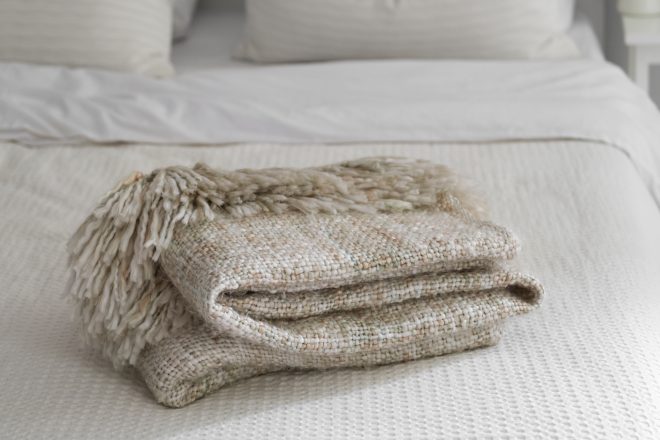
If you own a wool blanket, you already know it’s not just a blanket, it’s a loyal companion. It’s there for cozy movie nights, crisp autumn mornings, and those winter evenings when the world feels just a little too cold. But here’s the thing: at some point, that beloved wool blanket is going to need a wash.
The thought of shrinking it down to toddler size terrifies many people. I get it, wool has a bit of a diva reputation. It’s luxurious, but high-maintenance.
The good news? I have been caring for wool textiles, everything from chunky merino throws to fine alpaca blends, for years, and I can tell you with absolute confidence: washing wool without shrinking it is completely doable. The trick is knowing exactly what not to do and following a few tried-and-true steps.
Why Wool Shrinks (And Why You Need to Care)
Wool differs from synthetic fibers and cotton. It is composed of small, overlapping scales that resemble roof shingles. Those scales fall together when they are exposed to heat, moisture, and friction. Wool shrinks and stiffens because of this.
Trouble is caused by three primary culprits:
- Hot water: Wool loves cool to lukewarm baths. Hot water is its worst enemy.
- Agitation: Rubbing, wringing, or tossing it around in the washer can cause felting.
- Harsh detergents: Strong soaps strip away lanolin, the natural oil that keeps wool soft, springy, and resistant to dirt.
Understanding this is essential because it clarifies the rationale behind our gentle approach. Not only are you cleaning your blanket, but you are also preserving the fibers’ structural integrity.
How Often Should You Wash a Wool Blanket?
A little insider tip: it’s likely that you won’t need to wash your wool blanket as frequently as you may believe. Wool is naturally dirt-repellent and odor-resistant. It will usually be revitalized by simply letting it air out on a windy day.
You can get away with washing it only once or twice a year unless it’s obviously filthy or has acquired a strong odor (from a campfire, for example, or from an enthusiastic pet).
Choosing Your Cleaning Method
Hand washing a wool blanket is the safest method. That’s what I personally use, especially for blankets that hold special meaning for me. However, some wool blankets are marked as “machine washable,” so if yours is, you can use the wool or delicate cycle on your washing machine. However, keep in mind that hand washing still gives you more control.
Pay attention to the care label if it states “dry clean only.” Some wools are treated in a way that causes them to distort when exposed to water.
The Hand Wash Method (Best for Most Wool Blankets)
I can assure you that this method is effective, even though I can’t remember how many wool blankets I’ve hand washed over the years.
You’ll need:
- A clean tub or basin
- Wool-safe detergent (look for something labeled “wool wash” or “delicates”)
- Cold or lukewarm water (around 30°C / 86°F)
- Several large towels
Step 1: Prepare the bath
Fill your tub with cool or slightly lukewarm water. Too hot, and you risk shrinking.
Step 2: Add detergent
Use just a teaspoon or two for a full tub. Wool detergents are pH-balanced and lanolin-friendly, so they clean without damaging the fibers.
Step 3: Submerge gently
Lay the blanket in the water slowly, letting it soak for about 10–15 minutes. Don’t rub or twist—let the water and detergent do their thing.
Step 4: Rinse carefully
Drain the tub and refill with fresh, cool water. Gently swish the blanket to rinse out the soap. You may need two rinses.
Step 5: Remove water without wringing
Support the blanket evenly as you lift it. Wool gets heavy when wet. Lay it flat on a towel, roll it up, and press (don’t twist) to remove excess moisture.
Drying Wool the Right Way
Many people make the mistake of hanging a wet wool blanket here. It will become stretched and deformed.
Instead:
- Lay it flat on a dry towel in a well-ventilated area.
- Reshape it to its original dimensions.
- Let it dry naturally no direct sunlight, no heaters, no dryers.
The outcome is a soft, precisely shaped blanket that is prepared to keep you warm once more, but it does require patience (24–48 hours).
Pro Tips for Keeping Your Blanket Fresh Between Washes
Think of these as your “blanket life hacks”:
- Air it out: Once every few weeks, give it a day outside on a breezy line.
- Spot clean: For small spills, blot gently with cold water and a dab of wool-safe detergent.
- Protect it from moths: Store it in a breathable cotton bag with cedar blocks or lavender sachets.
Why Regular Laundry Detergent is a Wool Blanket’s Enemy
It’s important to reiterate that ordinary detergents are made to remove oil, which works well for oily kitchen towels but poorly for wool. The lanolin found in wool is not merely a luxury; it is what gives the fibers their flexibility and durability. Your blanket will become less durable and softer if you remove it.
Choose a mild, lanolin-friendly detergent if you only buy one wool-specific product. It’s a tiny action that has a big impact.
Final Word: Treat Your Wool Like a Friend
I like to think of wool care the way I think about friendships nurture them, treat them with respect, and they’ll be around for the long haul. Your wool blanket has been keeping you warm, cozy, and comforted. The least you can do is return the favor with a little TLC.
Follow these steps and you’ll never have to fear washing day again. You’ll have a blanket that stays as beautiful and functional as the day you brought it home and maybe even better, because it’s full of your memories.
GIPHY App Key not set. Please check settings